News (2022)
Congratulations to our bachelor students
December 22, 2022
In the last months five bachelor students successfully handed in their theses: Marie Scheffen (Radialgeschwindigkeitsvariationen Roter Riesen und Blauer Horizontalast-Sterne), Fabian Mattig (Radial Velocity Study of Hot Subdwarf Stars), Henry Willems (Hunting for the progenitors of helium white dwarfs), Eric Woege (Analyse von heißen, unterleuchtkräftigen Zwergsternen aus dem ZTF-Survey) and Ramon Jaeger (Eclipse timing variation of hot subdwarf binaries).
Studying the population of hot subdwarf binaries with light curves from space
October, 2022
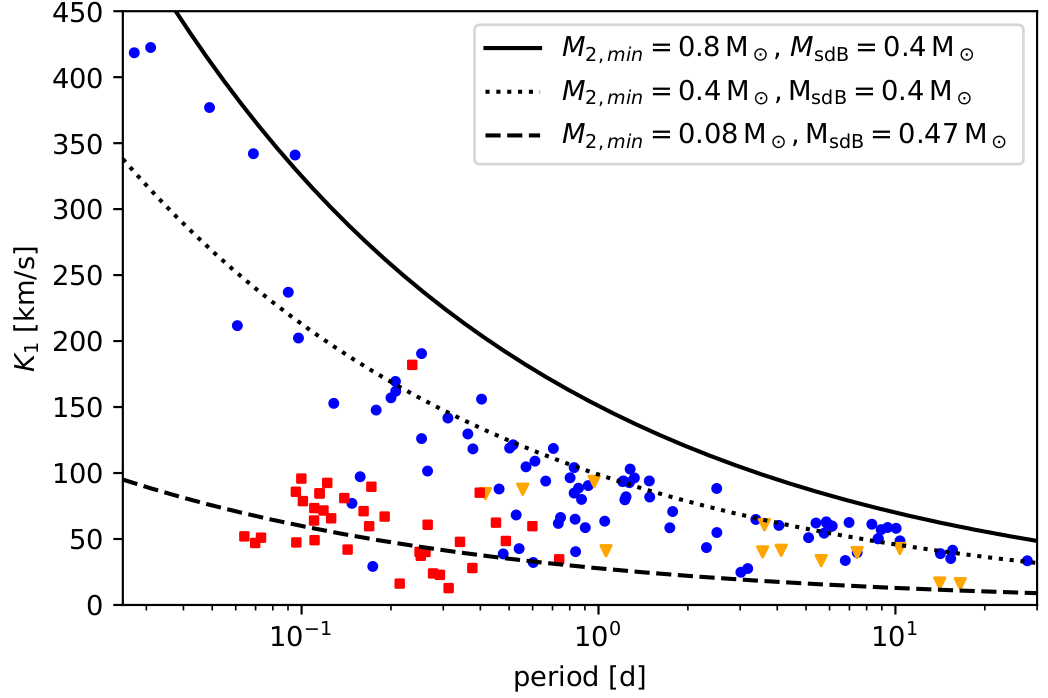
Minimum companion mass distribution (blue: white dwarfs, red: M dwarfs and brown dwarfs, yellow: unknown companion types) of all known short-period sdB binaries with spectroscopic solutions and with TESS or K2 light curves. Image credit: A&A.
By classifying the light variations and combining these with the fit of the spectral energy distribution, the parallax distances, and the atmospheric parameters, we could derive the nature of the primaries and secondaries in 122 (75%) of the known sdB binaries and 82 newly found reflection effect systems. We derived absolute masses, radii, and luminosities for a total of 39 hot subdwarfs with cool, low-mass companions, as well 29 known and newly found sdBs with white dwarf companions. The mass distribution of hot subdwarfs with cool, low-mass stellar and substellar companions, differs from those with white dwarf companions, implying they come from different populations. By comparing the period and minimum companion mass distributions, we find that the reflection effect systems all have M dwarf or brown dwarf companions, and that there seem to be several different populations of hot subdwarfs with white dwarf binaries. This extensive study was led by Veronika Schaffenroth.
Annual Meeting of the German Astronomical Society
September 17, 2022
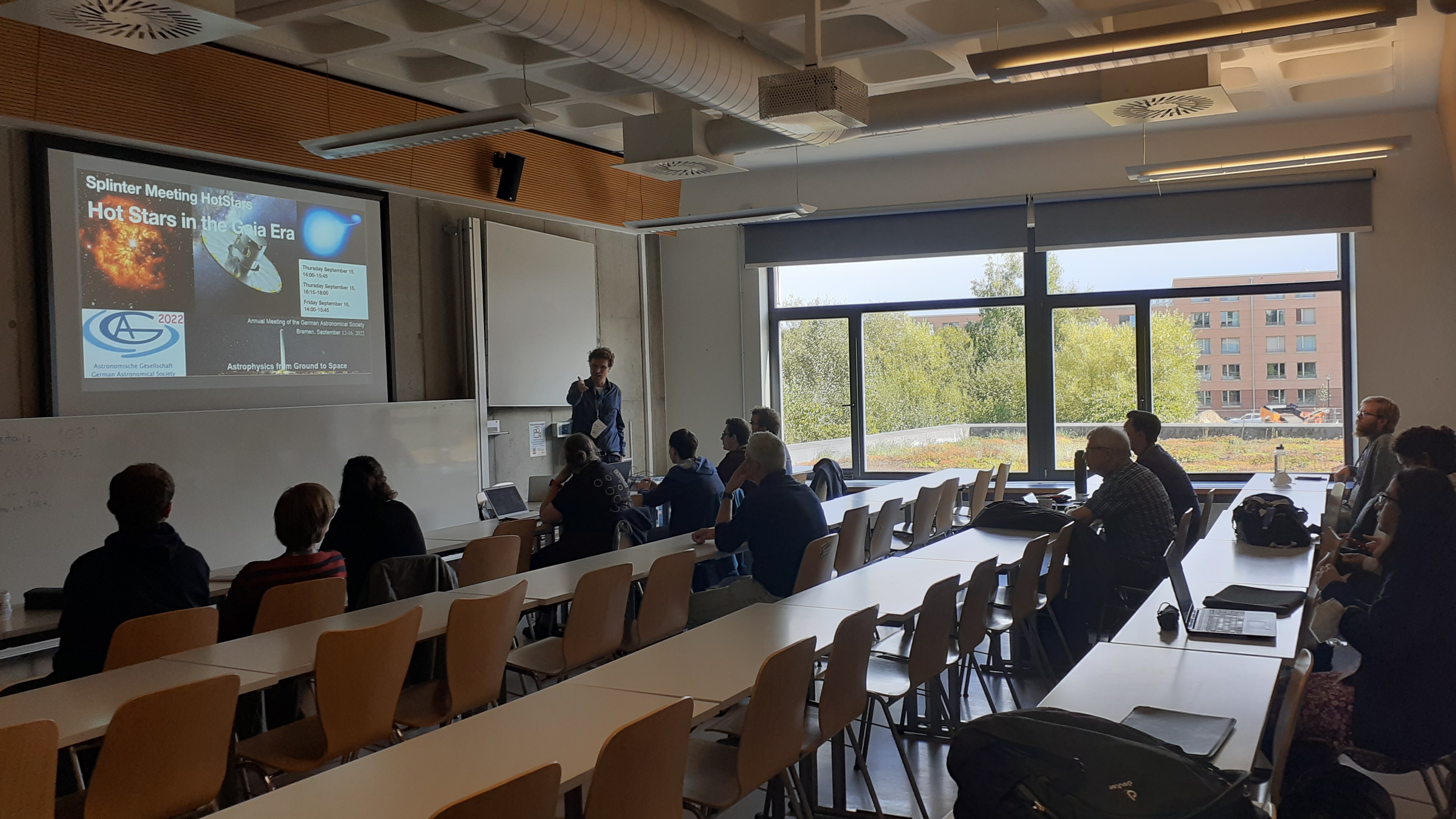
Hot stars in the Gaia era splinter at the Annual Meeting of the German Astronomical Society.
From September 12 to 16 we attended the Annual Meeting of the German Astronomical Society in Bremen. Two members of our group, Nicole Reindl and Veronika Schaffenroth, organised - together with two other German colleagues - a splinter meeting dedicated to "Hot stars in the Gaia era". During this splinter many of our students had the opportunity to present the results of their work and we could learn about the challenges involved in analyzing other types of hot stars, such as Wolf-Rayet stars, or hot supergiants and main-sequence stars. Finally, Veronika Schaffenroth gave an excellent plenary talk on the impact of TESS on our understanding of compact binary stars.
European Workshop on White Dwarfs in Tübingen
August 31, 2022
Conference group picture.
From August 14 to 19 we attended the European Workshop on White Dwarfs in Tübingen to hear and discuss what will happen to hot subdwarfs in a later stage of their lives.
Welcome to Matti Dorsch
July 7, 2022
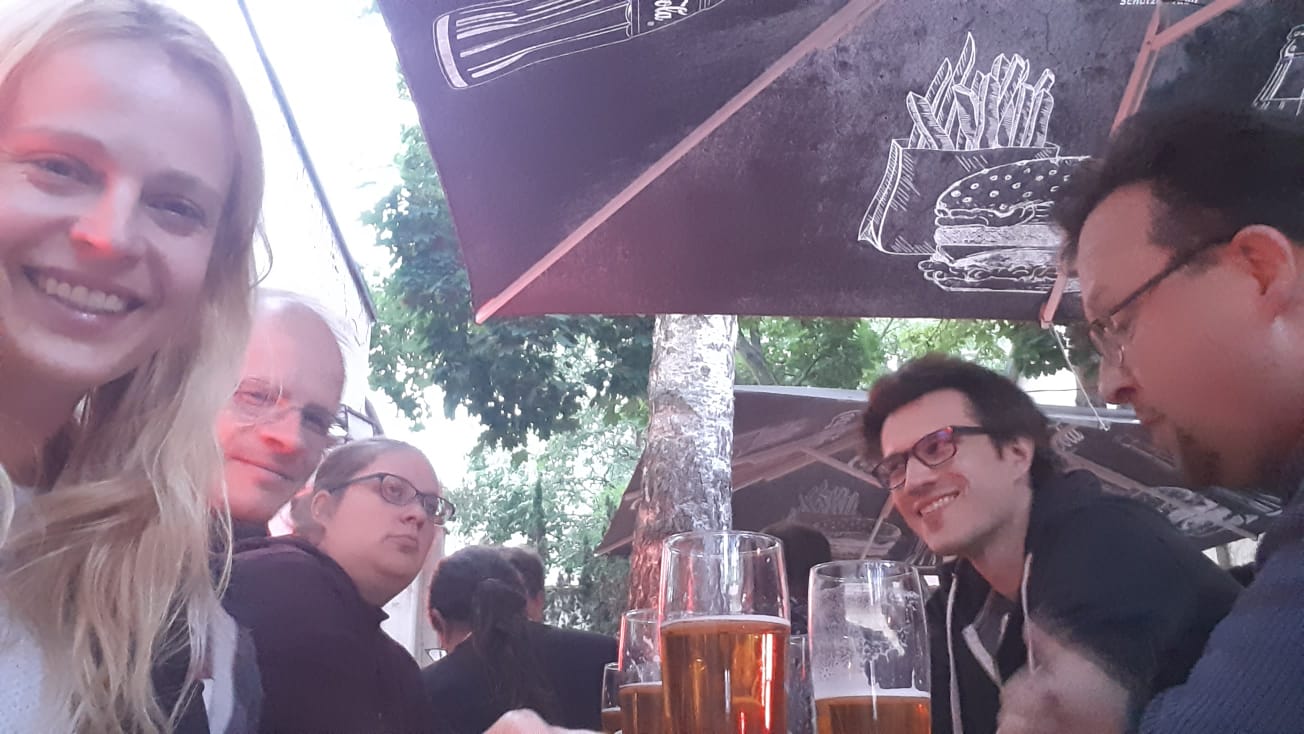
We are very happy to welcome Matti Dorsch as a new research fellow in our group. He will be analysing photometric and spectroscopic data of hot subdwarf stars.
Hot subdwarf meeting in Liege
June 24, 2022
Conference group picture.
From June 13 to 17 we attended the 10th meeting on hot subdwarfs and related objects in Liege, Belgium. It was a great pleasure to meet many old and new friends, to discuss about exciting, new scientific results, and to spent some cheerful evenings together.
New hot subwarf catalogs released
June 14, 2022

The known hot sub luminous stars shown on the Gaia colour-magnitude diagram. Image credit: A&A.
We have used the great improvement in the quality of the European Space Agency's Gaia space observatory's astrometric and photometric measurements in the latest data release to increase to
61,585 the number of hot subdwarf candidates. This increase of 55% compared to our previous catalogue from 2019 has been made possible by improving the detection and selection methods and
criteria. We have also used the latest data from the LAMOST spectroscopic survey from the National Astronomical Observatories, China to update and expand the catalogue of known hot subdwarf stars.
This latest version contains 6,616 hot subluminous stars representing an increase of 742 stars compared to our previous release of the catalogue in 2020.
Hot subdwarf stars are very old objects that are thought to require stellar interactions to evolve to their current state. One evolutionary path requires that the outer hydrogen layers of a star
are stripped through interaction with a stellar partner to expose its small, hot, and dense core. Studying hot subdwarfs gives us an insight into the binary interactions required to create such objects
as well as allowing us to directly study the cores of stars without the outer hydrogen layers hiding their secrets. These catalogues have been presented in a
paper by Rick Culpan, Dr. Ingrid Pelisoli, Dr. Nicole Reindl, and Prof. Stephan Geier together with colleagues from
the European Southern Observatory which has now been published in A&A.
And yet they move (or not)
May 12, 2022
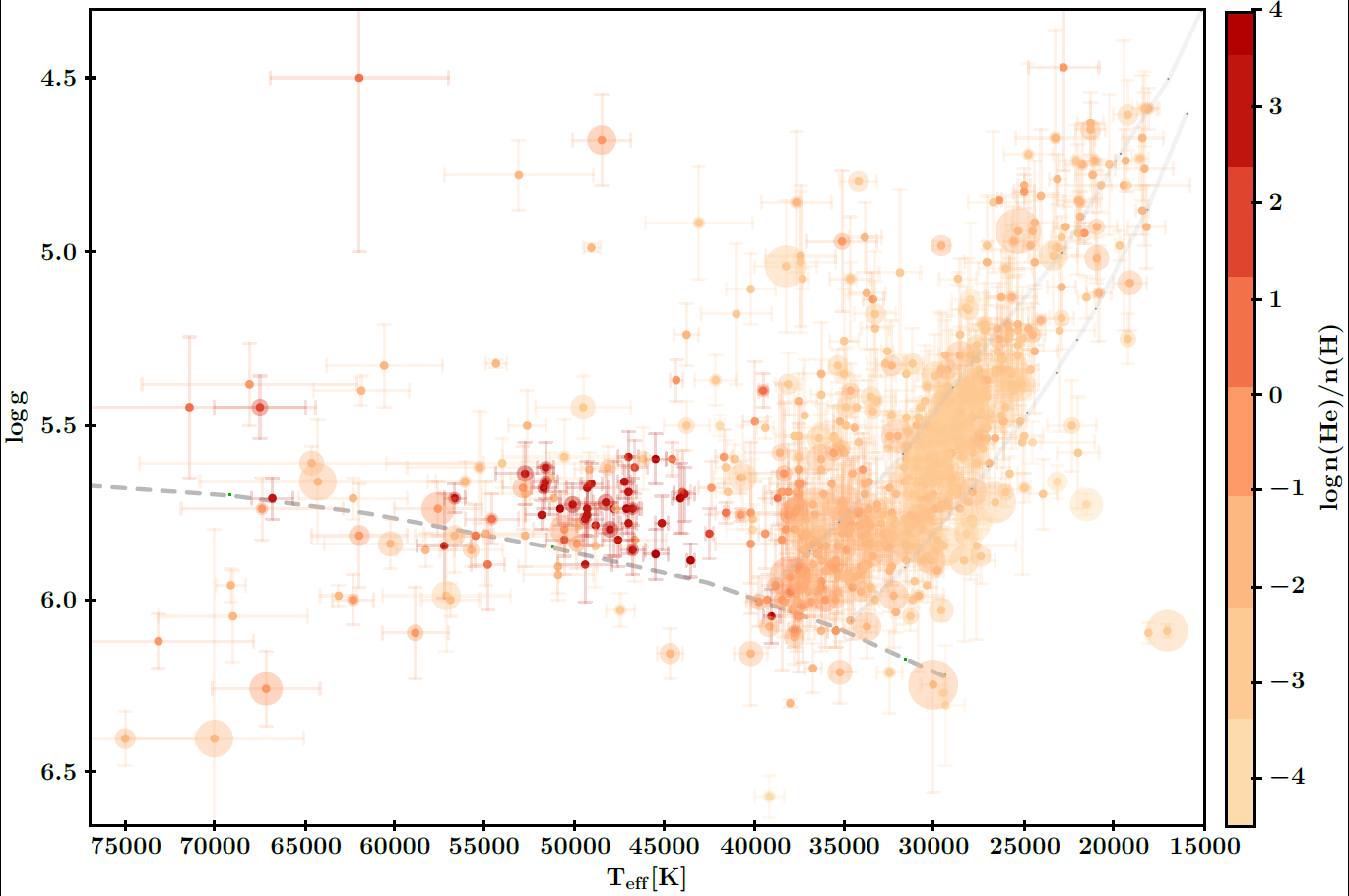
Image credit: A&A.
In a paper published in A&A we performed a radial velocity (RV) variability study of a sample of 646 hot subdwarfs with multi-epoch radial velocities based on spectra from large area surveys, which turned out to be quite inhomogeneous across the studied parameter ranges. A striking feature is the completely dissimilar behaviour of He-poor and He-rich hot subdwarfs. While the former have a high fraction of close binaries, almost no significant RV variations could be detected for the latter. This has led us to the conclusion that there is likely no evolutionary connection between these subtypes. On the other hand, intermediate He-rich- and extreme He-rich sdOB/Os are more likely to be related. Furthermore, we conclude that the vast majority of this population is formed via one or several binary merger channels. The coolest hot subdwarfs tend to show fewer and smaller RV-variations. These objects might constitute a new subpopulation of binaries with longer periods and late-type or compact companions. The RV-variability properties of the extreme horizontal branch (EHB) and corresponding post-EHB populations of the He-poor hot subdwarfs match and confirm the predicted evolutionary connection between them. Stars found below the canonical EHB at somewhat higher surface gravities show large RV variations and a high RV variability fraction. These properties are consistent with most of them being low-mass EHB stars or progenitors of low-mass helium white dwarfs in close binaries.
Rare stellar wedding
February 14, 2022

Artist's illustration of a double white dwarf merger. Image Credit: N. Reindl.
While hunting for hot stars with the Large Binocular Telescope in Arizona, we have discovered a completely new type of star. While normal stellar surfaces are composed of hydrogen and helium, the analysis - led by Klaus Werner from the University of Tübingen and involving several members of our team - revealed that surfaces of two stars are covered in carbon and oxygen - the ash of a helium nuclear fusion. This is a very exotic composition for a star and the situation becomes more puzzling because the new stars have temperatures and radii that indicate they are still burning helium in their cores. These results have now been published as a letter in the Monthly Notices of the Royal Astronomical Society. Published back to back with this article, a second paper from a group of astronomers from the University of La Plata and the Max Planck Institute for Astrophysics in Garching offers a possible explanation for their formation. Their work shows that these newly discovered stars might have formed in a very rare kind of stellar merger event between two white dwarf stars. For binary systems formed with very specific masses, a carbon- and oxygen-rich white dwarf might be disrupted and accreted on top of a helium-rich white dwarf one, leading to the formation of these stars.
Press release: Royal Astronomical Society, University of Potsdam, University of TübingenStrong magnetic field discovered in a hot subdwarf star
February 10, 2022

Zeeman-split He II 4686 Å line in the X-shooter spectrum of newly discovered and strongly magnetic hot subdwarf J0809-2627. Image Credit: A&A.
As the stars evolve, so do their magnetic fields. While impressive, the magnetic fields of stars such as the Sun are weak compared to the extremely strong magnetic fields observed for about 20% of white dwarf stars, which can reach strengths of hundreds of megagauss (MG). The origin of these strong fields yet remains unclear. Matti Dorsch, a PhD student in our group, and several members of our team have recently discovered a strong magnetic field in a hot subdwarf star (about 340 kG). For the first time, they modeled the spectral lines of this prototypical magnetic subdwarf, which are split by the linear Zeeman effect (see the figure above). This analysis, published as a letter in A&A, shows that this star will likely evolve to become an extremely magnetic white dwarf.
Looking into the cradle of the grave
January 5, 2022
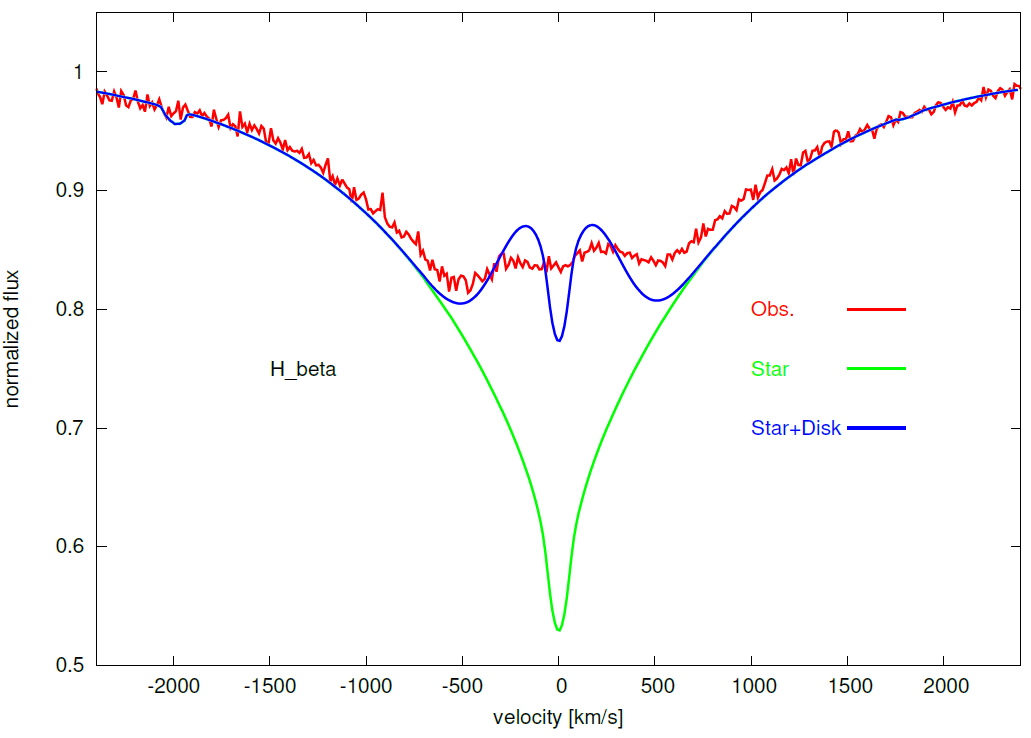
The observed Hβ line (red) can be understood as a single broad absorption from the stellar photosphere filled in by a double peak emission from the circumstellar material. Image Credit: A&A.
Joris Vos (former Humboldt fellow in our group) and several members of our team, have recently discovered a new type of hot subdwarf, named J22564-5910. It is rapidly spinning and gas is still present in the systems. All observational evidence points towards J22564-5910 being observed very shortly after the merger phase that formed it. It is the first post-merger star observed this early after the merger event, and as such it is very valuable system to test merger theories. The study got now published in A&A.
2023 2022 2021 2020 2019